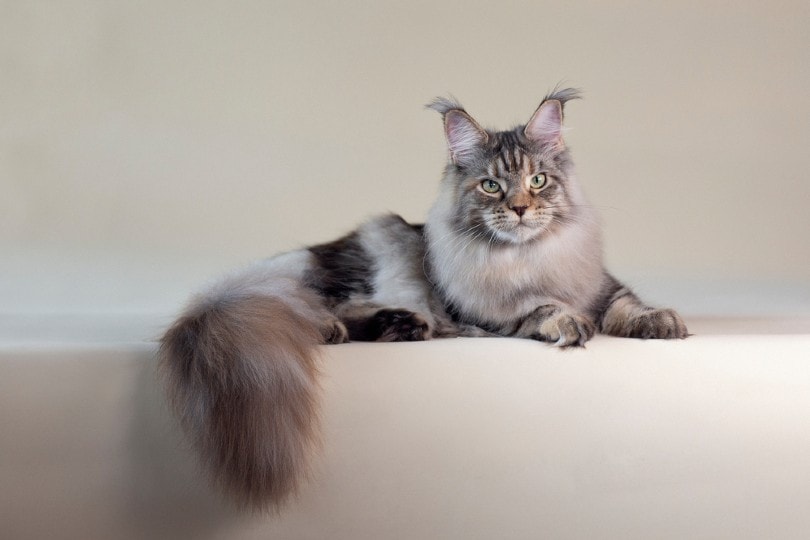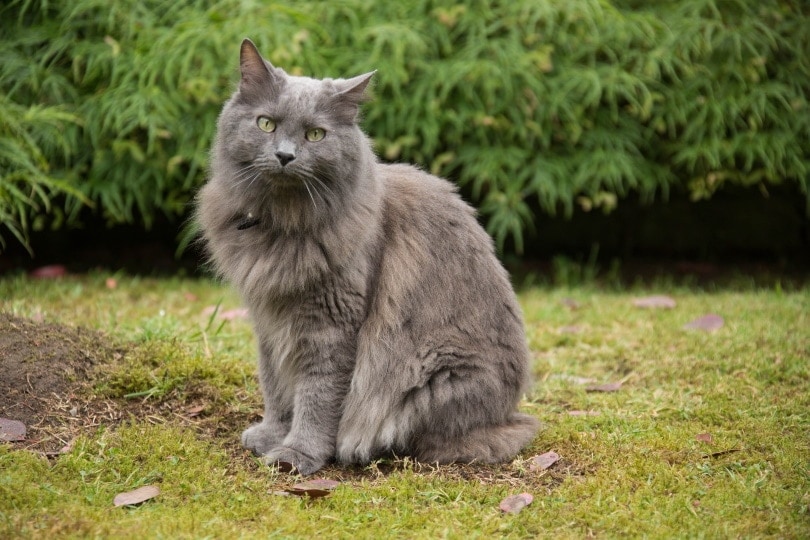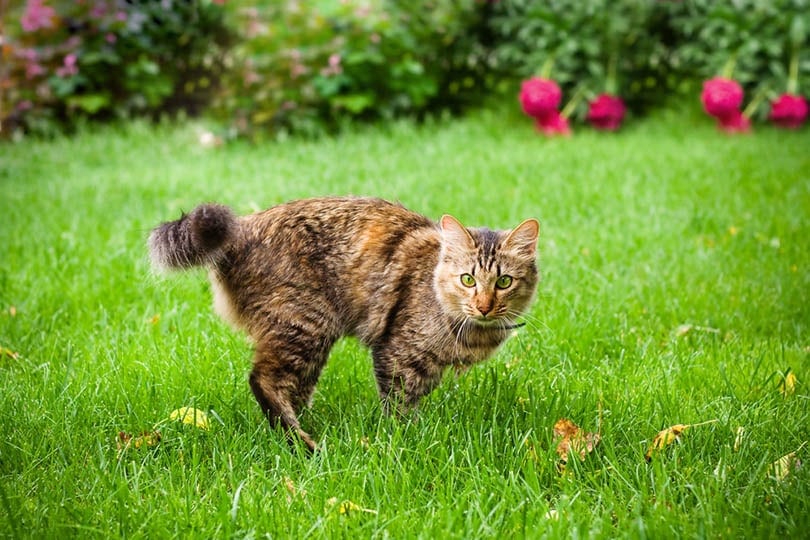Persian Ragdoll Cat Mix – Info, Pictures, Temperament & Traits
By Lorre Luther
Updated on
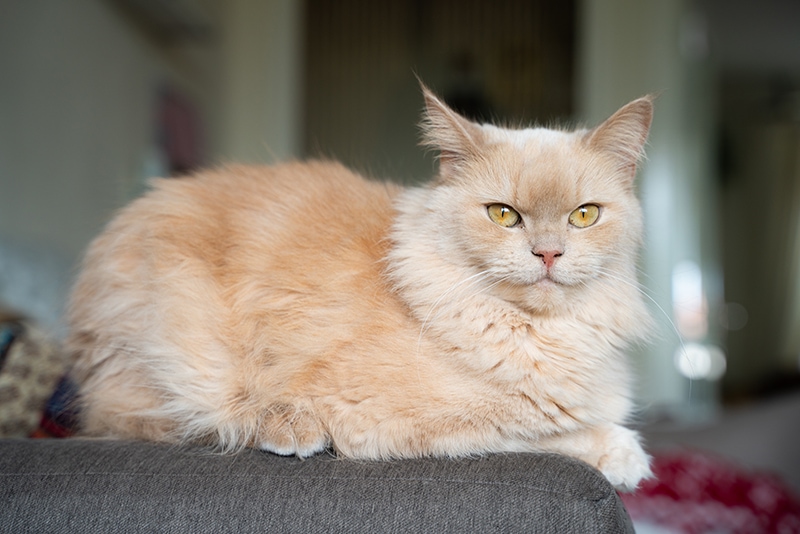
| Height: | 9–15 inches |
| Weight: | 7–20 pounds |
| Lifespan: | 10–17 years |
| Colors: | White, black, red, golden, and chocolate |
| Suitable for: | Families and individuals who spend lots of quiet time at home |
| Temperament: | Affectionate, quiet, friendly, and mellow |
Persian Ragdoll cat mixes are designer pets created by breeding pedigree Persian cats with Ragdoll kitties. As first-generation hybrids, Persian Ragdoll cats inherit behavioral and physical characteristics from both parents, making it difficult to predict how any individual pet will look or behave.
Some Persian Ragdoll cat mixes have the long thick hair of their Persian cat parents and require a fair amount of grooming to prevent tangles. Others have the fine, silky single-coats of Ragdoll cats and only need minimal weekly brushing. Pets with Persian cat-like temperaments may be slightly standoffish and disinterested in engaging with new people. Kitties who lean toward their Ragdoll cat heritage may be a bit more relaxed when interacting with unknown people and animals.
Persian cats and Ragdoll cats do have some temperamental overlaps, making it likely that most Persian Ragdoll cat mixes will also exhibit these qualities. Persian cats and Ragdoll cats bond deeply with family members and are often quite loyal, and they’re also mellow and undemanding. While both breeds enjoy companionship, they’re often happy just doing their own thing with their favorite people nearby.
Persian Ragdoll Cat Mixes – Before You Bring One Home…
The price of Persian Ragdoll cat mixes can be difficult to predict. As designer cats, they’re not covered by a breed standard. Since they can’t be registered with most cat fancy organizations due to their mixed heritage, it can often be difficult to find breeders working with these cats. Some breeders may charge less since the cats can’t be registered with cat fancy organizations. Rescue organizations may also have adoptable mixed cats available for less than you’d pay through a breeder.
3 Little-Known Facts About Persian Ragdoll Cat Mixes
1. Persian Cats Participated in the First Organized Cat Show
Persian cats are an incredibly old breed. Their ancestors were brought to Europe from Persia during the 17th century. Persian cats were shown at Harrison Weir’s groundbreaking cat show in 1871. They arrived in the US during the last few decades of the 19th century; the Cat Fanciers’ Association (CFA) recognized the breed back in 1906.
Queen Victoria was a Persian cat fan, and Florence Nightingale is rumored to have had several Persian cats over her lifetime. Other famous Persian cat lovers include Marylin Monroe and Kate Beckinsale. Persian cats were the 4th most popular breed in the US in 2021.
2. Persian Cats Haven’t Always Had Short Noses
Persian cats originally had elongated noses, but the short nose trait emerged as a spontaneous genetic mutation in the 1950s. The look became popular, and breeders began selecting for brachycephalic traits. Starting in the 1980s, breeders began moving away from selecting extremely short noses and faces due to health-related concerns.
Doll Face Persian cats have the traditional longer faces of their ancestors and usually don’t suffer from conditions associated with brachycephalism. Doll Face Persian cats don’t conform to cat show standards, so they often cost less than their brachycephalic breed mates.
3. Ragdoll Cats Are A Relatively Young Breed
Ragdoll cats haven’t been around as a breed for very long. They were developed in the 1960s by a California breeder, Ann Baker, who mixed a semi-feral white cat with her Persian cats. Ragdoll cats were only recognized by the CFA in 1998!
They were the most popular pedigree cats in the US back in 2021. They’re often described as dog-like due to their mellow natures and love of hanging out with their humans. While pedigree Ragdoll cats come in several colors, including cream and seal, all have blue eyes. Several celebrities, including Taylor Swift, Seth Green, and Sylvester Stallone, have owned Ragdoll cats.
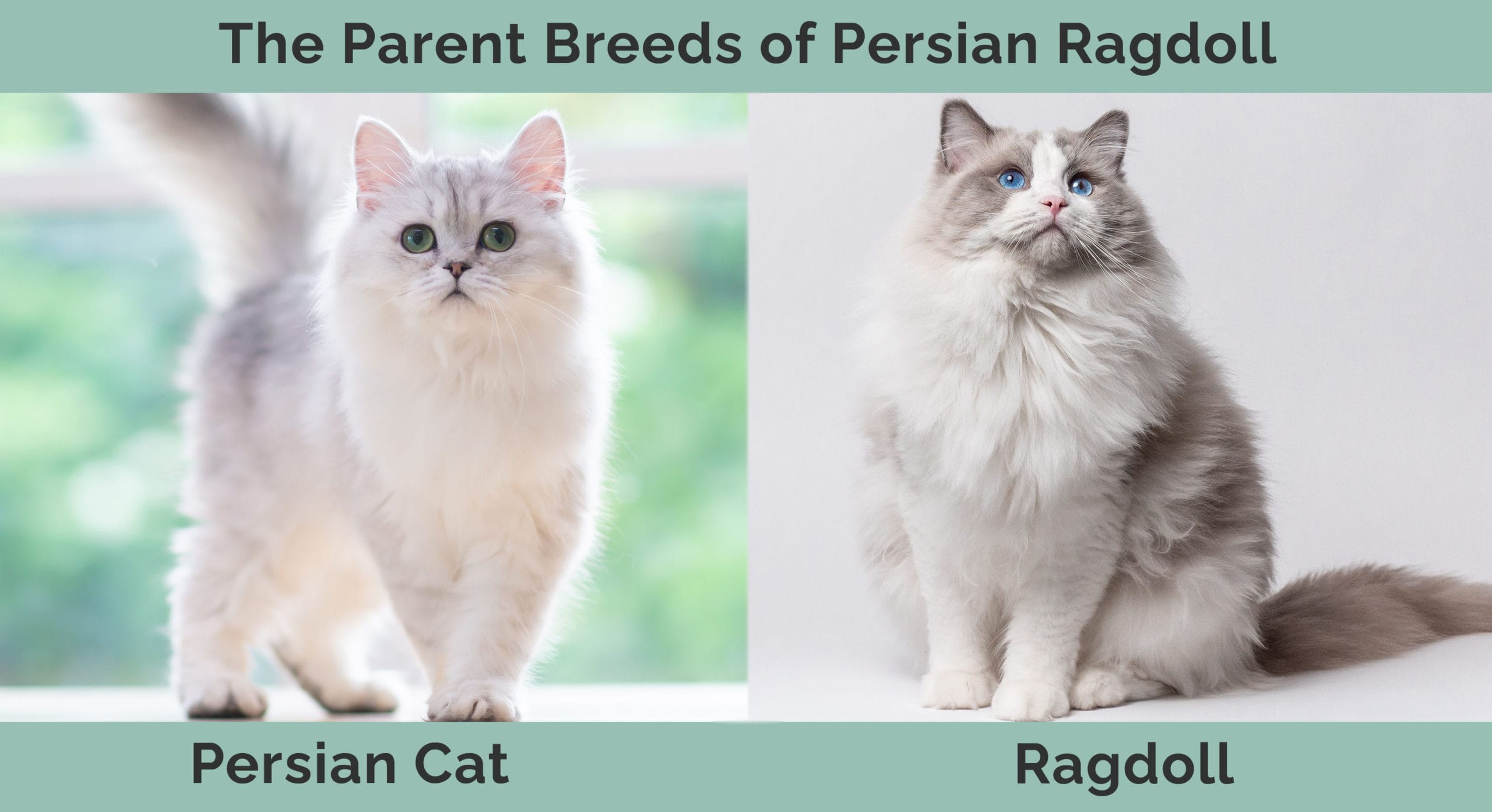
 Temperament & Intelligence of Persian Ragdoll Cat Mixes
Temperament & Intelligence of Persian Ragdoll Cat Mixes
Persian Ragdoll cat mixes exhibit qualities and characteristics of both parent breeds, but what comes from each parent varies with each cat, making things like temperament and intelligence hard to predict. Because both Persian cats and Ragdoll cats tend to be mellow and laid back, there’s a good chance any Persian Ragdoll cat mix will be as well.
Are Persian Ragdoll Cat Mixes Good for Families? 👪
Persian and Ragdoll cats usually do exceptionally well in family settings since they bond deeply with people and are extremely loyal to those considered part of their inner circles. Both are relatively low-energy breeds, so there’s a good chance a Persian Ragdoll cat mix will be perfectly happy just hanging out on the couch. The mixes’ parent breeds tend to do well with children.
While neither breed tends to be demanding, both do best when receiving lots of attention. Persian Ragdoll cat mixes are great for families and individuals who enjoy quiet activities at home and have lots of time for pets.
Do Persian Ragdoll Cat Mixes Get Along With Other Pets?
Persian cats and Ragdoll cats usually get along quite well with other pets. Both breeds can warm up to well-behaved dogs, but some cats may have issues with hyperactive puppies or energetic breeds. Neither Persian nor Ragdoll cats have high prey drives, so you most likely don’t have to worry about a Persian Ragdoll cat mix becoming fixated on resident small mammals such as mice or guinea pigs. Most pet owners find that cats and dogs who grow up together tend to get along relatively well.
Things to Know When Owning a Persian Ragdoll Cat Mix:
Food & Diet Requirements 🐡
Neither Persian cats nor Ragdoll cats have special dietary needs. Persian Ragdoll cat mixes should eat high-quality cat food that delivers the full range of required nutrients without exceeding their caloric limits. Look for options that meet AAFCO guidelines, as these are complete nutritional choices that provide all the protein, vitamins, and minerals healthy cats need. Pet parents can choose from several options, including wet food, dry kibble, fresh meals, or freeze-dried food.
Make sure to follow the feeding instructions and measure serving sizes to prevent overfeeding, as Ragdoll cats tend to gain weight easily and often suffer from obesity. Fresh water is important to keep cats properly hydrated. Sufficient water intake can help minimize cats’ chances of developing urinary tract conditions, such as bladder stones and infections. Cat fountains can go a long way towards ensuring Persian Ragdoll cats drink enough water for optimal kidney and urinary tract health.
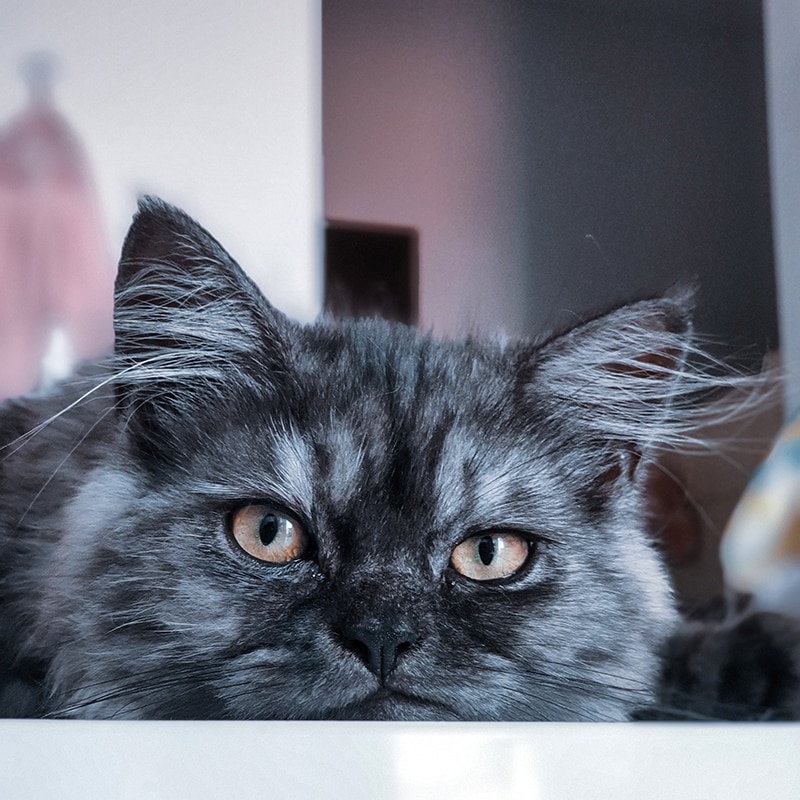
Exercise 🐈
Persian cats and Ragdoll cats are relatively mellow. Neither breed has exceptionally high activity requirements, but cats require exercise to stay mentally and physically fit. Playtime provides an opportunity for fun human-feline bonding and a chance for cats to get physical activity. Cats have relatively limited attention spans when it comes to organized playtime, and two 10–15-minute sessions are ideal.
Most cats need about 20 to 30 minutes of daily exercise. Some Persian Ragdoll cat mixes built more like Ragdoll cats may benefit from extra movement to help prevent weight gain. Kitties with Persian-cats-like features may struggle a bit with exertion due to their short noses and jaws. Some might have difficulty breathing freely when engaging in physical activity, so pay close attention to your pet’s comfort level if they have brachycephalic characteristics.
Training 🧶
Both cats are reasonably easy to train if you have the time and interest. Like all cats, they do best with positive training methods and often respond well to clicker training since it helps them identify desired or targeted behaviors. Walking with your cat can be an excellent feline-human bonding activity. Consider using a harness if you plan to walk your cat.
Not only do harnesses make it more difficult for kitties to squirm loose while outside, but they also attach under your cat’s belly and chest, so the leash doesn’t put pressure on your pet’s neck. Give your pet plenty of time to get used to the harness before heading outside, and keep in mind that your cat will likely spend more time sniffing than walking when you first hit the great outdoors together.
Grooming ✂️
Kitties with Persian-cat-like fur require frequent grooming. Most need daily brushing to prevent serious tangles and massive amounts of shedding. Kitties with brachycephalic features may also require regular eye stain cleaning.
Pets with Ragdoll-cat-like coats only need weekly brushing. Persian Ragdoll cat mixes, like all kitties, require regular nail trims. Aim for once every 2 weeks, and try to brush the cat’s teeth at least three times a week. Just make sure to use veterinary toothpaste, as human products contain fluoride, which is toxic to cats.
Health and Conditions 🏥
Persian Ragdoll cat mixes can develop conditions and diseases seen in their parent breeds. Persian cats are at increased risk for developing serious conditions such as polycystic kidney disease (PKD), hypertrophic cardiomyopathy (HCM), and feline infectious peritonitis (FIP). They’re also more likely than non-pedigree cats to have eye problems, hip dysplasia, and respiratory issues.
Ragdoll cats, as a breed, are at heightened risk for both PKD and HCM. But many are extremely healthy, with some living into their late teens. Ragdoll cats are often quite large, often tipping the scales at more than 20 pounds. The breed is prone to becoming obese, which is linked to a higher risk of developing chronic conditions such as diabetes, heart disease, and osteoarthritis.
Persian Ragdoll cat mixes can be incredibly healthy and live long lives. However, they can also inherit one of their parents’ breed-specific illnesses or suffer from conditions that can impact all cats, such as urinary tract infections and gum disease.
- Eye problems
- Respiratory problems
- Hip dysplasia
- Polycystic kidney disease (PKD)
- Hypertrophic cardiomyopathy (HCM)
- Feline infectious peritonitis (FIP)
Male vs Female
There’s not usually much difference between male and female domestic cats. Male cats tend to be slightly larger than female kitties, but the size difference is usually minimal.
Unneutered male cats often spray and mark territory with their claws and urine. They also tend to be more aggressive than neutered males. Unaltered females often become extremely affectionate and vocal when in heat, and driven by a biological urge to mate, many engage in escape attempts. Spayed and neutered pets don’t generally engage in these behaviors.
Kittens can be spayed or neutered once they reach around 6 weeks old. Some veterinarians suggest there may be health benefits associated with spaying female cats, including lower lifetime risks for developing some types of uterine and breast conditions.
Conclusion
Persian Ragdoll cat mixes make wonderful pets, even if they are a bit on the rare side. They’re a charming mixture of two of the most popular cat breeds in the US. Because they’re first-generation mixes, these cats inherit physical and temperamental traits from both parents. Persian Ragdoll cat mixes are often mellow and relaxed, and most enjoy spending time just being around their human companions.
These hybrid cats are likely to be good with children since Persian cats and Ragdoll cats are usually extremely patient with family members. Persian cats and Ragdoll cats are both incredibly devoted to their loved ones, so the chances are pretty high that any Persian Ragdoll cat mix will be the same.
Featured Image Credit: Dirk-Jan de Graaf, Shutterstock



